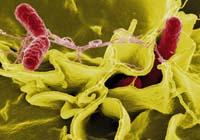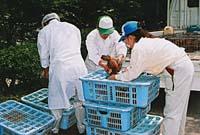Animal diseases for men

Diseases that are transmitted from animals to people are called zoonoses. There are many zoonoses, it should be noted that of the 1,415 infectious agents that affect people, about 61% (that is, almost two out of three) pass from animals to people. Normally these are bacteria, parasites or viruses that can reach people in different ways: direct contact with animals, ingestion of food of animal origin, water or food contaminated by animals, among others.
Several zoonoses have become protagonists of the news during a season. Who does not remember the crisis of mad cows? Later the SARS virus triggered the alarm and a few months ago the avian flu. Issues related to them were often mentioned in the media, and they also influenced people's customs, for example, for fear of avian influenza, chicken consumption declined.
Many other zoonoses do not appear in the media. But that doesn't mean they don't deserve attention. In fact, the "normal" zoonoses that do not appear in the news reports are the ones that most concern health officials, who are the ones that cause the most infections. In particular, diseases caused by bacteria of the genus Salmonella and Campylobacter are the main zoonoses both in the Basque Country and throughout Europe.
In both cases, the first sources of infection are animal foods, mainly eggs and poultry, or their products. In many cases these products are already contaminated in the nursery itself. In fact, in many chickens and nurseries there are pathogens, but birds do not have symptoms even if they are infected. Therefore, if eggs and meat are not treated properly, there is a risk of infecting the consumer.
In fact, just do the eggs and meat well to destroy the bacteria. However, some raw food may be in contact with them, causing the infection. This is known as cross-contamination. Moreover, mayonnaise and other products are made from raw eggs, hence many of the summer infections occur.
However, the symptoms of infection are similar in both cases: diarrhea, nausea, abdominal pain, fever... In the face of salmonellosis, Camylobacter infections are individual, do not become infected to whole groups and affect especially people with a weak immune system such as children, patients and the elderly. Normally none of them cause death, but they are a serious public health problem.

The core of the problem
In order to combat the bacteria Salmonella and Campylobacter, several plans have been implemented in recent years. In Gipuzkoa, for example, a project was launched in late 2001 with the aim of reducing the prevalence of both bacteria by 15% by 2007.
In addition, the European Union has developed a new regulation for each country to establish Salmonella control programmes in egg-hens, the main focus of egg contamination. Through such programmes, the countries of northern Europe (Denmark, Norway, Sweden...) have already achieved very good results. There they hardly have Salmonella, and here they also want to get a similar situation in four or five years.
Thus, this year all the eggs have been incorporated. Thanks to this, hens and eggs are protected from infection, decreasing considerably in the Salmonella. In addition, measures have been taken to prevent the entry and spread of infection in nurseries (biomeasures) and good practices have been strengthened. With all this, the prevalence of Salmonella is expected to decrease considerably. Following are campaigns on other birds and pigs.
However, prevention does not end there. Measures should be taken throughout the product journey from the nursery to the market and from there to the home. For example, it is imperative that consumers store and prepare food to minimize the risk of contamination.

With some basic measures it is not difficult to avoid these two infections. Therefore, based on household habits surveys, public health officials plan to conduct a campaign aimed at consumers to prevent salmonellosis. These same measures will help reduce Campylobacter infections. In fact, just as anti-AIDS measures also protect against other sexually transmitted diseases, those against Salmonella also serve against Campylobacter.
Remuneration of work
There is no denying that sometimes campaigns give good results. Brucellosis and tuberculosis transmitted by livestock have gone from widespread throughout the Basque Country to virtually no case. Both diseases are also caused by bacteria -- Brucella and Mycobacterium bovis --, and are pathogenic to both livestock and people.
The bacteria of the genus Brucella affect cows and sheep, among others, being able to reach people through their meat, blood or raw milk. The bacteria are able to survive within the phagocytes of the immune system, so it tends to be chronic and in acute infections it is characteristic to cyclically raise and lower the fever. In addition to fever, chills, muscle and joint pain, and sweating are other symptoms of acute infection.
Tuberculosis is the most deadly infectious disease in the world. The causative agent is normally Mycobacterium tuberculosis, but they estimate that approximately 3% of cases of tuberculosis are produced by the M. bovis variant. Transmission routes are raw milk from sick cows and aerial inhalation.

Much work has been done on the eradication of these diseases, which can be seen in the data: In Gipuzkoa, for example, the prevalence of TB jeans in the 1980s was 4% and in 2005 it was 0.26%. All jeans are controlled and all are designated without tuberculosis. The same goes for brucellosis.
Gipuzkoa data is an example of Euskal Herria. Occasionally a cow with tuberculosis or brucellosis appears, usually in Bizkaia, but it is contaminated by the cattle of Cantabria.
As in the cows, in the sheep the situation is very good: we have been without remnants of brucellosis and tuberculosis for years. In addition, control is simpler than in cows, since in Euskal Herria grow latxa sheep, created and marketed in the territory itself, there is no risk of entry of sick animals. The exception is the south of Navarre, where sheep of meat of another breed grow in which some cases of brucellosis appear.
Of course, livestock work affects public health. Thus, few people acquire tuberculosis or brucellosis, which are often contaminated with food purchased outdoors, such as cheese made from raw milk.
To maintain good results, ranchers continue to conduct thorough studies and control. Among other things, if they detect sick animals, they kill all the stables and then follow up. The slaughterhouses carry out the usual analyses and control all movements and transactions of livestock. In the field of public health, control and monitoring is carried out by those responsible for food security, in collaboration with the area of epidemiology.

Viral zoonoses and parasites
Although salmonellosis, tuberculosis and brucellosis are produced by bacteria, not all zoonoses are bacterial. In fact, the two zoonoses, avian influenza and anisakiosis that have most recently appeared in the media have been produced by a virus and a parasite, respectively.
A few months ago there was a lot of talk about avian flu and now it is back to talk. However, all prevention measures are prepared so that there is not a single infection, nor in birds of hamlets and nurseries, much less in people.
However, it is important to remember that it is extremely difficult for anyone to get avian influenza, as it must be in close contact with infected birds, since the H5N1 virus is transmitted by air. It has never become sick with poultry, nor has it been confirmed that it has been transmitted from one person to another.
In fact, the risk of the H5N1 virus is that if a variant could be transmitted from one person to another, a pandemic could occur. XX. The three influenza pandemics of the nineteenth century were probably of animal origin: 1918 (probably bird), 1957 (pig) and 1968 (bird). To prevent this from happening, health and livestock organizations have taken very demanding measures globally and at all levels. In addition, researchers are working to address the situation if the worst hypothesis becomes reality.

In other ways, anisakis has also been an important issue in the media, at least in Hego Euskal Herria. The Ministry of Health and Consumption published in December a Royal Decree ordering the anticipated freezing of fish to eat little or raw. The goal is to destroy the parasite called anisakis. The order has given a lot to talk about, especially because there are high-level cooks who take out very unprepared fish and consider that if the fish freezes before it loses quality.
Apart from the gastronomic debate, the anisakis parasite is widespread and its larvae are easily localizable in cracks and cephalopods that are usually consumed. They are found in your digestive system, but can spread to the surrounding muscles and organs. Heat (above 60ºC) and cold (for example, 24h to 20ºC) destroy, but not smoking or marinade. Therefore, the ingestion of products that have suffered this type of treatment or raw fish can cause parasitization of the consumer.
The larva of the parasite produces in people a disease called anisakiosis that affects the gastric intestines: acute pain, ulcer, hemorrhage... It produces itchy skin and many patients also react allergic. If larvae are not removed, the disease can become chronic.
It seems that the cases of anisakiosis are intensifying and that is why the Ministry of Spain has issued the royal decree. Japan and Scandinavia are many people who get sick, but in Spain and Euskal Herria, although they eat a lot of fish, there are very few cases.
Food as main concern

The zoonoses mentioned to date are those transmitted by animals intended for consumption and many others: Q fever (by sheep), hepatitis virus (by shellfish)... But domestic and wild animals also transmit diseases to people. For example, although it has never been in the Basque Country, rabies is an important zoonosis in some parts of the world. According to the WHO, around 55,000 people die each year from the rabies virus, especially children, through bites of infected dogs.
However, zoonoses transmitted through food are the main concern in Euskal Herria and Europe, which are the most common. In addition, this concern also manifests itself in consumers and is heightened whenever a problem occurs.
To combat this, European Union food security officials consider it a priority for consumers to rely on the food they eat. To do this, a global strategy based on three pillars is being implemented from the field to the table: legislation on food and feed, on the one hand, strong scientific advice and, finally, effective application of standards and comprehensive control. There is no “zero risk”, but at the same time food is safer than ever, and each with simple measures at home further reduces the risk.






